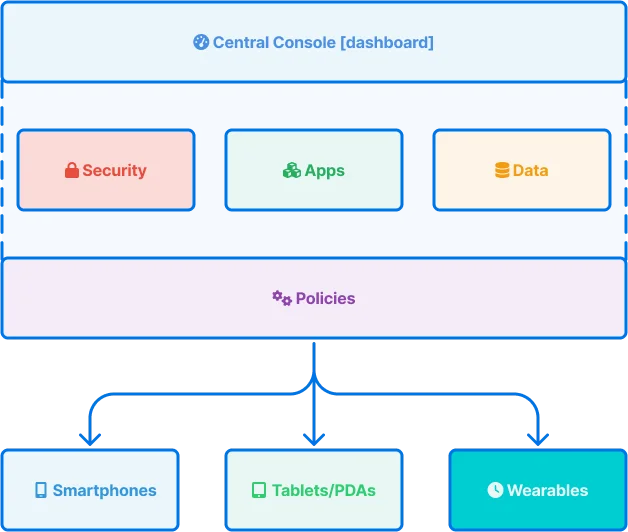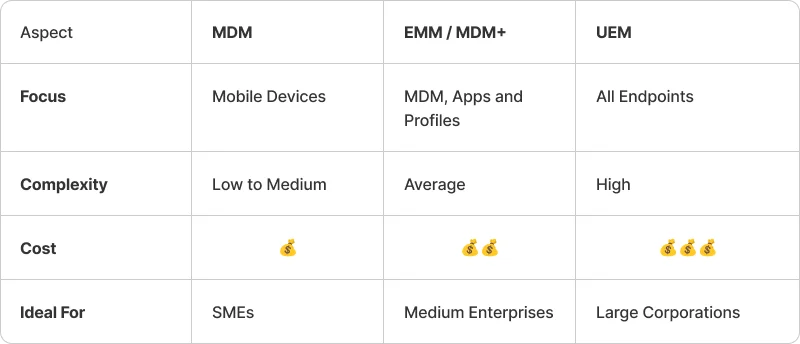Introduction
“In a world where mobility is no longer an option but a necessity, efficient management of mobile devices has become the central pillar of digital transformation."
Imagine a classroom where 30 tablets are instantly configured for a new educational activity. Or a retail chain where hundreds of POS devices are updated simultaneously overnight. Or a logistics fleet where each driver has their device perfectly configured for their specific routes.
This is the reality that modern Mobile Device Management (MDM) delivers.
Enterprise mobility has become essential for modern businesses, but the growth in mobile device usage also brings significant challenges. Keeping these devices secure, up-to-date, and productive requires a structured approach.
Mobile Device Management (MDM) is emerging as a crucial solution for controlling, monitoring, and protecting devices used in the corporate environment. In this article, we will explore what MDM is, why it is essential for modern businesses, and how it can be integrated into your company’s mobility strategy. What does it really mean to implement an MDM solution, and why has it become indispensable?
What is Mobile Device Management (MDM)?
MDM is a software solution that enables centralized management of mobile devices, ensuring they are secure, properly configured, and aligned with corporate policies. It enables the enforcement of security rules, application control, and the protection of corporate data.
The MDM journey reflects the evolution of enterprise mobility itself:

Read our article that explains in-depth what is MDM here
Main components of an MDM solution:

- Control devices remotely.
- Definition and application of security policies.
- Application and permission management.
- Device monitoring and tracking.
- Contingency actions such as remote blocking or wiping of data.
MDM vs EMM vs UEM
- MDM : Focuses on managing mobile devices, ensuring security and remote control.
- EMM (Enterprise Mobility Management) / MDM+ : More advanced than an MDM, includes more complete device management, also covering applications, content and corporate profiles.
- UEM (Unified Endpoint Management) : Expands the concept to include not only mobile devices, but also computers, IoT, and other endpoints.

Why is MDM Essential for Modern Businesses?
Challenges in Mobile Device Management:
- Lack of control over devices : Devices can be used to access corporate data without adequate security measures.
- Risk of data loss : A lost or stolen device can expose sensitive information.
- Difficulty keeping devices up to date : Outdated software can create vulnerabilities.
- Productivity issues : Employees may install unauthorized applications, reducing work efficiency.
How Does MDM Solve These Problems?
- Centralized management: Allows you to control all devices from a single platform.
- Security policy enforcement: Ensures devices are always protected.
- Application and update distribution: Reduces vulnerability risks.
- Access management: Defines which applications and networks can be used.
- Increased productivity: Avoid distractions and improve team efficiency.
Benefits of MDM for Businesses
- Enhanced security : Protects corporate devices and data from unauthorized access.
- Greater control : Set rules for app installation and device usage.
- Increased productivity : Keeps devices configured for strictly professional use.
- Cost reduction : Avoids expenses with support, maintenance and device replacement.
- Regulatory compliance : Ensures adherence to standards such as LGPD and GDPR, protecting business and customer data.
How Does MDM Fit into Your Company's Mobility Strategy?
MDM is a key component of corporate mobility, as it allows companies to benefit from the use of mobile devices without compromising security or productivity. It is also essential for companies that adopt the BYOD (Bring Your Own Device) model , as it allows them to separate personal data from business data on the same device.
In the context of remote work, MDM ensures that devices used outside the office follow the same security policies and are always monitored.
How to start implementing MDM in your company?
The implementation plan follows six main steps:
- Scope and expectations assessment : Identification of the solution's objectives, risks that the company wants to mitigate and implementation and maintenance challenges.
- Profile and Action Planning : Analysis of device usage profiles, survey of applications used, definition of configurations and restrictions, in addition to mitigation of possible problems.
- Planning and Preparation : Training teams, configuring policies according to profiles, and adapting asset management and support processes.
- Approval of Profiles and Functionalities : Testing of the solution on controlled devices and distribution to a real sample.
- Distribution/Deployment : Communicating with users, controlling distribution, deploying to uncontrolled (BYOD) and controlled devices.
- Maintenance and Support : Ongoing management with installation of new applications, policy adjustments and planning for EMM/MDM updates.
The focus is on ensuring a structured implementation, with risk control, validation in tests, clear communication with users and continuous maintenance.
Conclusion
The use of mobile devices brings agility and flexibility to businesses, but it also increases the need for control and security. MDM is an indispensable solution for any modern company looking to protect its data, ensure team productivity and reduce operational costs.
If your company has not yet implemented an MDM solution, now is the ideal time to evaluate this need.
Why Choose Nomid MDM?
As an Android Enterprise Silver Partner, Nomid MDM offers:
Simplicity : Intuitive interface that reduces the learning curve
Security : Enterprise-grade certifications and LGPD compliance
Support : Specialized technical team
Innovation : Monthly updates with new features
ROI : Proven results in 60 days or less
Request a demo of Nomid MDM and see in practice how it can transform the management of your mobile devices.
Request a demo of Nomid MDM and see in practice how it can transform the management of your mobile devices.
Request a demoShare this article
Tags
- #mdm


